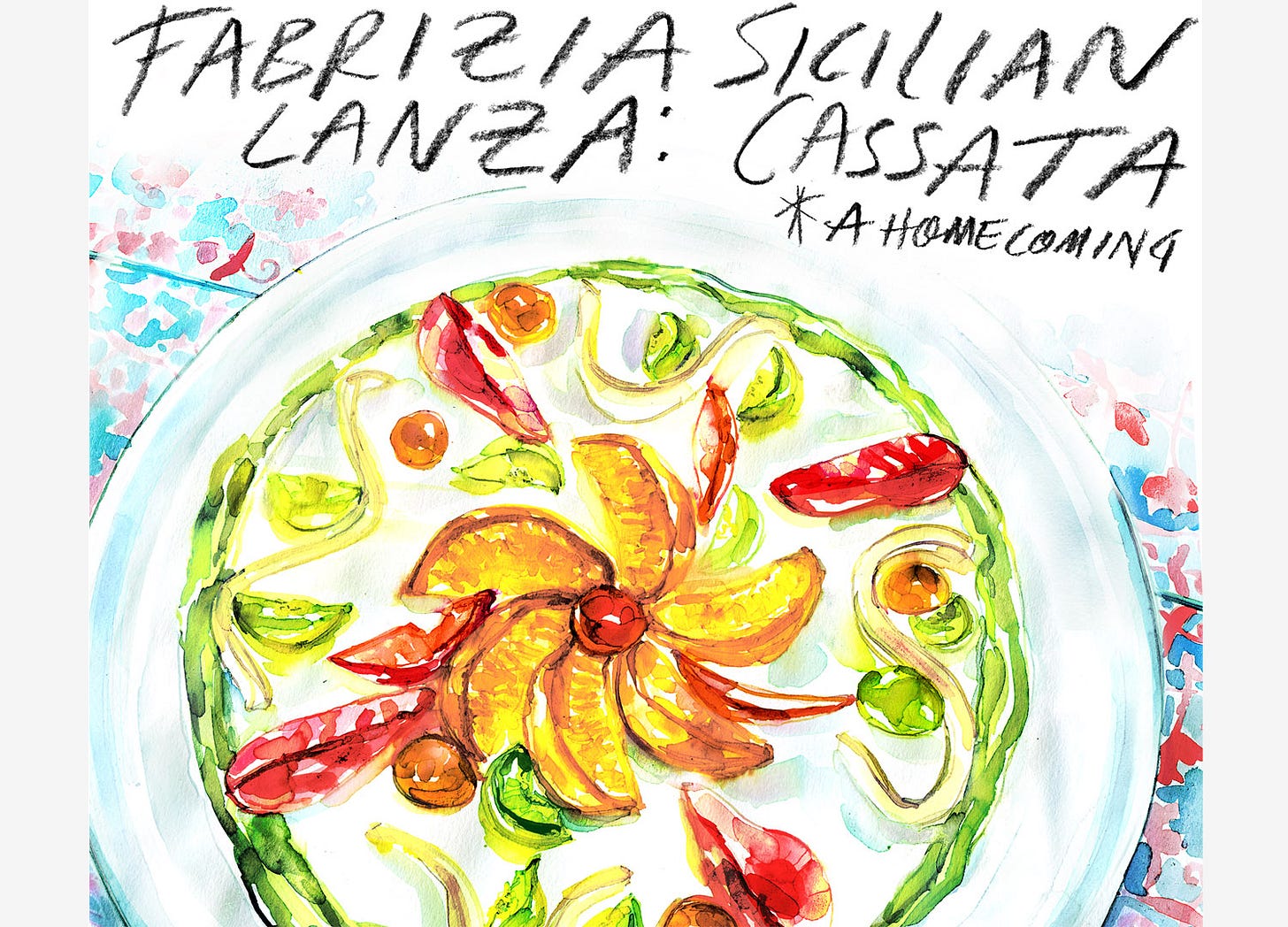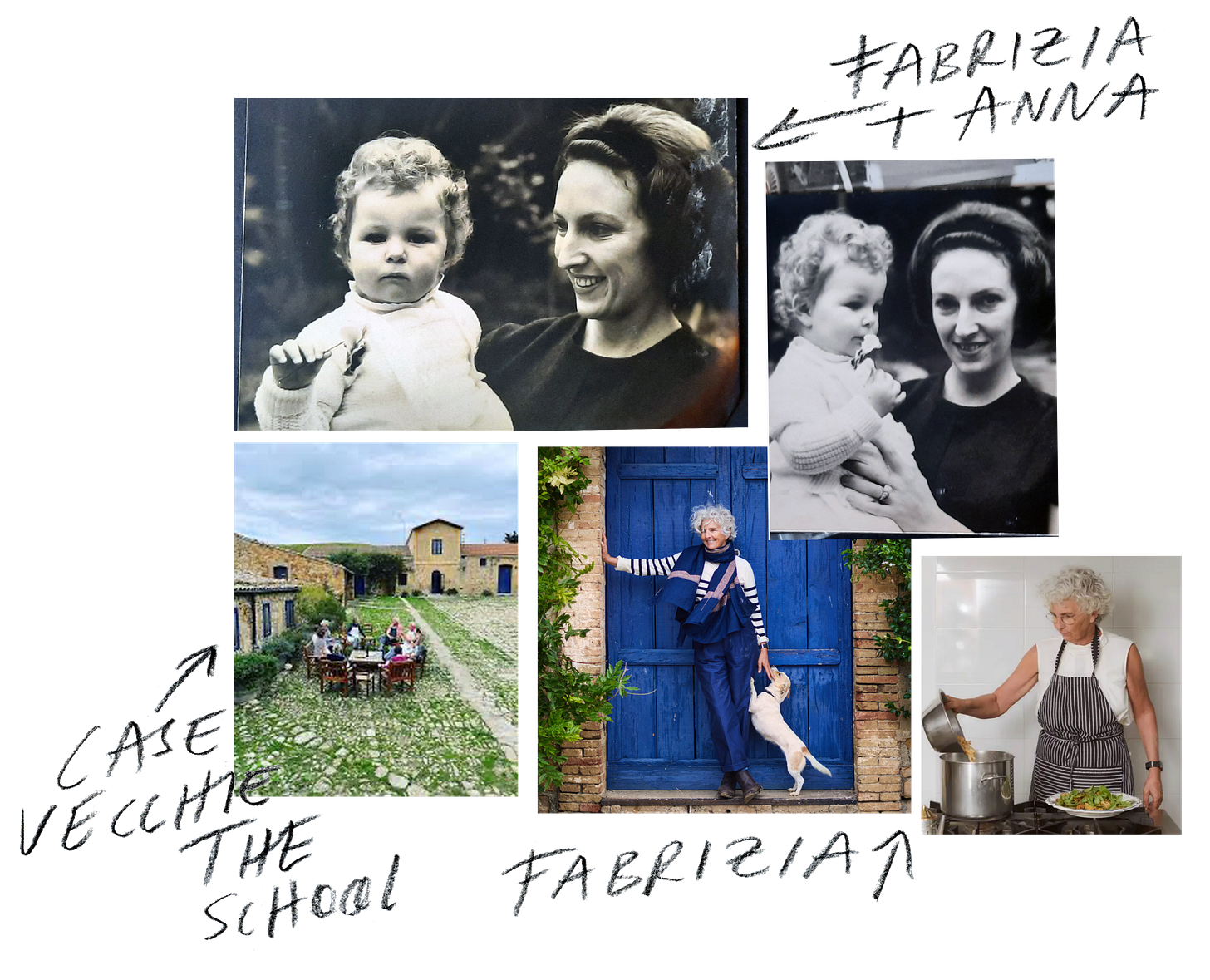Fabrizia Lanza: Sicilian Cassata
The Director of Anna Tasca Lanza Cooking School, founder of Cook The Farm, and author of Coming Home to Sicily, shares her mother's Cassata, a variation on the classic Sicilian sponge cake.
Italy has a special place in my heart. I studied art for a semester abroad, in Florence. To this day, my host mother’s peas in homemade olive oil stand as one of the most memorable meals of my life, and my visit to the Aeolian Islands in Sicily as my favorite trip, even though especially since my friend and I missed the ferry and spent the night sleeping on a black sand beach beneath Stromboli.
Recently, I had the incredible opportunity to speak Fabrizia Lanza, an art historian who found her way back home to Sicily to join her mother at the Anna Tasca Lanza cooking school she founded. Fabrizia now directs the school as well as Cook the Farm, a program she founded to offer hands-on, place-based experiences rooted in immersion, connection, and regeneration. Check out her cookbooks, The Food of Sicily, and Coming Home to Sicily.
Nestled in the heart of rural Sicily, among wheat fields, olive groves, and vineyards, the school introduces students to Sicily’s deep-rooted food systems and agricultural traditions. Their teaching approach is grounded in regenerative continuity, honoring the past while making space for innovation, inclusivity, and ecological care.
The recipe below our interview is Fabrizia’s mother’s version of cassata siciliana, a traditional Sicilian sponge cake.
Tell us about your recipe.
This isn’t the story of me cooking next to my mother. Growing up, my mother had a cook in the house. I was an only child, and this cook was a little bit my nanny, my babysitter, my grown-up sister. There wasn't this picture of my mother and me cooking together, learning next to her elbow. I was away from Palermo by 18. I earned my PhD in art history. I came back when I was 42. My mother had opened the cooking school.
It was complicated, because working with your mother is not always easy, but also a fantastic journey of feelings, of new rediscovery. When you're 18, you're aware, but at the same time, you don't think like when you are 40 or 50. All the things that I had tasted or seen or ways of doing things came back to me, so I stayed.
My mother taught me Cassata. It's not a complicated recipe; it requires perfect ingredients and some patience. It’s something that I've always thought of her, and I also love to do it. In Sicily, sweets are overly sweet. My mother taught me to slow down on sugar, and this makes the Cassata we make at the school particularly delicious. It's very articulate and engaging in terms of flavor. That was my mother's legacy for me.
Did being with her at the cooking school bring you closer?
I don't know, honestly, in the sense that, for me, it was a rediscovery. And it was huge emotionally. I had the chance to assist during my mother's illness because she, after a few years, started to be not so great. She had dementia and Parkinson’s. It was a blessing that I came back. I would have been very sad if all this had happened without me here. I had a chance to re-establish a relationship between her and me, although we were never apart. But, you know, I left when I was 18, and I had a husband, I had two kids, I had a career. I was distant, let's say. When I came back, we started again.
You spent your childhood in the city, but also spent time in the countryside near vineyards, olive groves, and wheat fields. Did you start Cook the Farm to connect the kitchen with the fields?
We lived in Palermo because the schools were in Palermo. The place is very remote. It's not a place where you grow up unless you are the son of a villager. We used to go there for holidays, for the harvest, with my grandparents. We in Sicily are deeply connected to the land. The produce when I was growing up was absolutely seasonal, grown nearby. You wouldn't buy certain stuff if it wasn’t in season. We received fruits and vegetables from the countryside, from Regalia, where the school is. Every week, somebody would bring us stuff, and then we would go to the market. The markets were very local. It was in the 70s. Italy, and Sicily even more so, was still very agrarian, as it had been for centuries.
Cook the Farm started when I moved to Sicily and started living on the farm. I still had a lot of questions. Unless you grow as a farmer, you don’t know why an onion tastes better in October than in June. Or why we should plant certain things at certain moments of the year, and so on. This was a world governed by men, by farmers, who are the worst communicators on Earth. Every time I had a question, I’d ask, and because I own my little farm, I would say, But is this better? Why is this better? I never got a satisfying response.
So I said, Well, now I'm going to nail this down. And I started ingredient after ingredient to understand what growing that stuff meant, stuff like wheat or almonds or tomatoes, whatever, and what effect the growing process, the farming process, had on the flavor of things. That was very, very, very interesting to me. Cook the Farm started because I had all these questions. I had some answers, and I wanted to share this particular knowledge, which, if you don't live on a farm or are in a city, you have no idea about.
What compelled you to write your cookbook?
A cookbook is something you do because it's like pulling out what you've done, where you are, and showing it to the world. Coming Home was my first cookbook. It was done with two other lovely people who were interning at the school, Kate Winslow and Guy Rosino. It was my rediscovery of Sicilian flavors. My mother had passed away. I was running a school completely alone, and I think it felt like a moment to put a pen in my hands and gather what I had learned so far, all these curiosities, all these questions, and all these emotions that had arisen and committed and shuffled my heart until then.
Cassata Siciliana
“My mother taught me to slow down on sugar, and this makes the Cassata we make at the school particularly delicious. It's very articulate and engaging in terms of flavor. That was my mother's legacy for me.”
Serves: 10–12
Ingredients
Sponge Cake
6 eggs, at room temperature
150 g (¾ cup) sugar
150 g (1 cup minus 1 tablespoon) flour, sifted
1 teaspoon orange or lemon zest (optional)
45 ml (3 tablespoons) limoncello or Grand Marnier (or bergamotto liquor, as in the lesson)
Ricotta Cream
1 kg (2.2 lbs / 35 oz) fresh ricotta, drained in the fridge for 2 days
200 g (1 cup) granulated or powdered sugar
Marzipan
350 g (about 3 cups) almond flour
150 g (1¼ cups) ground pistachios (optional)
200 g (1 cup) powdered sugar
5 ml (1 teaspoon) honey
20 ml (2 tablespoons) water
Pureed chard (blanched) for coloring — add 1 tablespoon at a time until desired shade is reached
For garnish: Candied fruit
Icing
300 g (2½ cups) confectioners’ sugar
Juice of 1–2 lemons, as needed
Equipment
23 cm (9-inch) springform pan
23 cm (9-inch) cassata pan or sloped-edge pie pan
Mixing bowls
Electric beater
Plastic wrap
Rolling pin
Whisk or rubber spatula
Serrated knife
Preparation in Advance
Bake and cool the sponge cake.
Drain the ricotta for 2 days in the refrigerator.
Measure and weigh all marzipan ingredients.
Measure sugar for ricotta cream (you may not need all).
Step-by-Step Method
1. Make the Sponge Cake
Preheat oven to 160°C (320°F).
Butter and flour a 9-inch springform pan.
Beat eggs in an electric mixer for 5 minutes.
Add sugar and zest (if using) and continue beating until mixture forms a ribbon when poured — about 20 minutes, until tripled in volume.
In 2–3 additions, gently fold in sifted flour with a rubber spatula.
Pour into prepared pan and bake 25–30 minutes, or until a toothpick inserted in the center comes out clean.
Cool completely on a rack.
2. Make the Marzipan
Combine almond flour, ground pistachios (if using), and sugar in a bowl.
Make a well in the center; add honey, water, and a few drops of food coloring or pureed chard.
Mix and knead until smooth and uniform in color.
Lightly dust the workspace with powdered sugar.
Roll dough into long strips about ½ cm (¼ inch) thick and long enough to wrap around the pan edges.
Wrap unused marzipan in plastic and refrigerate.
3. Prepare the Pan
Line a 23 cm (9-inch) cassata pan or sloped pie pan with plastic wrap.
Place marzipan strips along the inside edge, slightly overlapping ends, pressing to form a smooth layer.
4. Assemble the Base
Slice sponge cake vertically into 1¼ cm (½ inch) slices. Trim crusts.
Arrange a layer of cake slices in the bottom of the pan.
Drizzle with liqueur.
5. Make Ricotta Cream
In a bowl, combine the drained ricotta and sugar.
Whip with a whisk or spatula until smooth and evenly blended.
6. Layer the Cassata
Spread ricotta cream evenly over the sponge base.
Add another layer of cake slices on top.
Drizzle again with liqueur.
Press down firmly to compact.
7. Invert and Unmold
Place a large serving plate over the pan.
Flip the cake onto the plate, pressing firmly on the bottom to seal.
Remove the pan and peel away the plastic wrap.
8. Make the Icing
Sift half the confectioners’ sugar into a bowl.
Add half the lemon juice; stir until smooth.
Sift in remaining sugar and add remaining lemon juice, adjusting until you have a thin, glossy, spreadable icing.
9. Ice and Decorate
Spread icing over the top of the cassata, leaving green marzipan sides visible.
If marzipan is not colored, ice the entire cake.
Decorate with whole or sliced candied fruit.
Refrigerate for 1–2 hours to set before serving.
Suggested Timing (Approx. 1 hr 10 min active)
Intro: 5 min
Make marzipan: 10–15 min
Line pan with plastic: 5 min
Mix ricotta cream: 10 min
Roll marzipan strips: 5–10 min
Line the pan: 5 min
Slice cake: 10 min
Layer cake/liqueur/ricotta/cake: 10–15 min
Invert and press: 2 min
Make glaze: 5–10 min
Decorate with glaze and fruit: 5–10 min
Outro: 5 min




